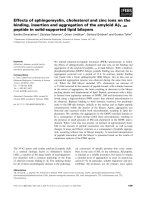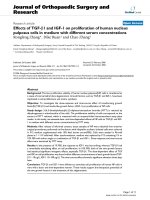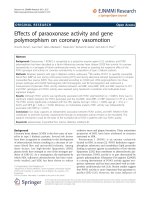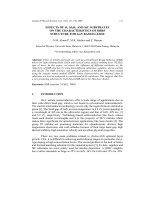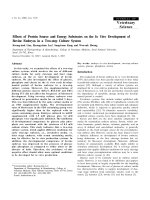Effects of air exposure and re submersion on o
Bạn đang xem bản rút gọn của tài liệu. Xem và tải ngay bản đầy đủ của tài liệu tại đây (780.47 KB, 12 trang )
The Israeli Journal of Aquaculture - Bamidgeh, IJA_69.2017.4000, 12 pages
+
The IJA appears exclusively as a peer-reviewed on-line openaccess journal at . To read papers free
of charge, please register online at registration form.
Sale of IJA papers is strictly forbidden.
Effects of Air Exposure and Re-Submersion on
Oxidative Stress of Marine Gastropod, Babylonia
areolata
Hui-Ling Liu, Shi-Ping Yang *, Wen-Jun Guo, Zhen-Hua Tan,
Siuming Francis Chan
Fisheries College, Guangdong Ocean University, Zhanjiang, China
Keywords: air exposure; re-submersion; oxidative stress; Babylonia areolata
Abstract
The effects of air exposure on the antioxidant capacity of marine
gastropod,
Babylonia
areolata,
were
evaluated.
Superoxide
dismutase (SOD) activity, malondialdehyde (MDA) content, and
total antioxidant capacity (T-AOC) levels in the muscle and
hepatopancreas in B. areolata were measured after air exposure and
re-submersion.
Results
showed
that
SOD
activity
minimally
increased in the hepatopancreas and muscle, after air exposure for 4
h. SOD activity in the hepatopancreas was lower than the normal
level after 20 h of air exposure and air exposure followed by 4 h of
re-submersion. T-AOC levels in the hepatopancreas and muscle of B.
areolata decreased significantly (P<0.05) following the period of air
exposure. MDA content in the hepatopancreas of B. areolata
subjected to air exposure for 24 and 28 h was significantly higher
than the normal level. SOD activity in the hepatopancreas and TAOC level in the hepatopancreas and muscle of B. areolata
recovered to the normal level after 12 h of air exposure followed by
8 h of re-submersion. Air exposure can cause oxidative damage to
B. areolata. The antioxidative system can be restored after air
exposure for less than 12 h followed by re-submersion for 8 h.
* Corresponding author. e-mail: Shi-Ping Yang, E-mail:
2
Yang et al.
Introduction
Normal oxygen consumption by aerobic organisms produces potentially reactive
oxygen species (ROS), including superoxide (O2-) and hydrogen peroxide (H2O2)
(Fridovich et al., 2004). ROS play a crucial role in various physiological processes.
In the intertidal zone culture model, Babylonia areolata lives in the intertidal
zone, which is a rigorous environment with extreme oxygen variations. To survive
in this environment, B. areolata must endure periodic changes in oxygen, water
availability, salinity, and temperature. The most serious situation is air exposure.
Furthermore, juvenile B. areolata are often cultured in concrete ponds and
transported to the intertidal zone. B. areolata suffer various forms of stress due
to current handling practices, air exposure, re-immersion, and size selection. Air
exposure is harmful to shellfish because it affects antioxidant defenses, immune
responses, acid base status, respiration, energy-producing mechanisms, and
survival (Chen et al., 2007; Dwyer and Burnett, 1996; Ellen et al., 2010).
Excessive ROS production can increase oxidative stress (Kim et al., 2009).
Environmental stresses, including air exposure, temperature, pH, algal toxin, and
metals, induce a generation of ROS in shellfish (Almeida et al., 2004; Almeida
and Bainy 2006; Qiu et al., 2013; Hu et al., 2015). Marine coastal ecosystems
contain varied oxygen concentrations. Intertidal organisms must cope daily with
large oxygen variations. These organisms are exposed to air twice a day during
low tide and thus experience periodic hypoxia or anoxia. With incoming tides,
tissues undergo rapid re-oxygenation, which potentially leads to hyperoxia
(Sussarellu et al., 2012). ROS production increased significantly in scallops
(Chlamys farreri) exposed to air at 17°C and 25°C (Chen et al., 2007).
The spotted babylon B. areolata, is widely distributed from Sri Lanka and the
Nicobar Islands through the Gulf of Siam, along the Vietnamese and Chinese
coast to Taiwan (Regteren and Gittenberger, 1981). B. areolata has been a
commercially important aquaculture species in China and Thailand but in nature,
its numbers are decreasing (Guilan et al., 2013; Chaitanawisuti et al., 2002). The
annual output of B. areolata is more than 1,000,000 kg, which corresponds to
more than $15 million in China (Guilan et al., 2013). There are several models for
culturing this species, including flow-through and static seawater systems in
concrete/canvas ponds, earthen pond culture model, and the intertidal zone
culture model (Kritsanapuntu al., 2009).
To the best of our knowledge, there are few papers on the effects of air
exposure and re-submersion on oxidative stress of shellfish species namely on
the bivalve Perna perna (Almeida et al., 2005), C. farreri (Chen et al., 2007),
Crassostrea virginica (Willson and Burnett, 2000), and freshwater gastropods
Nacella concinna (Ellen et al., 2010), and Cipangopaludina chinensis malleata
(Havel, 2011).
B. areolata is a marine gastropod that lives in intertidal zones where there are
extreme oxygen variations. Since we found no information on the response of
antioxidant enzyme activities to air exposure followed by re-submersion, we
studied the effects of air exposure and re-submersion on the behavior and
oxidant levels of B. areolata. Superoxide dismutase (SOD) activity, total antioxidative capacity (T-AOC) level, and malondialdehyde (MDA) content in the
Effect of air exposure and re-submersion on marine gastropods
muscle and hepatopancreas were determined after exposure to air and resubmersion. This study aims to provide a base for selecting marine zones for
culture, and for designing a suitable strategy to decrease oxidative stress and
mortality of B. areolata during transfer and other aquaculture activities.
Materials and Methods
Experiments were conducted in Zhanjiang Tengfei Industry Co., Ltd. (Zhanjiang,
Guangdong, P. R. China). A batch of apparently healthy B. areolata (mean body
weight 13.5 ± 0.5 g) was transferred to the laboratory from the culture pond.
Only healthy and undamaged individuals were selected and maintained in an airconditioned room at 28°C. They were fasted for at least 12 h prior to the
experiment.
The air exposure experiment was performed by placing them in individual
opaque foam tanks (120 L capacity) without water but covered with wet gauze to
maintain air humidity. Individuals were subjected to air exposure stress for 0, 4,
8, 12, 16, 20, 24, and 28 h. After air exposure at 28°C, individuals at different
points in time
were re-submersed in aerated seawater (28°C) for 4 h. In
another experiment, individuals exposed to air for 12 h were re-submersed in
aerated seawater (28°C) for 4, 8, 12, 16, 20, and 24 h. Various forms of behavior
were observed after air exposure and re-submersion.
Samples of hepatopancreas (digestive gland) and foot muscle were collected
after air exposure and/or re-submersion for analysis of antioxidant parameters.
For each condition and sampling time (air exposure and re-submersion), 3
individuals were sampled and analyzed respectively. All B. areolata individuals
were placed on ice prior to anesthetization and dissection. The excised
hepatopancreas and muscle tissues were homogenized in Tris-HCl buffer (pH 7.4)
at 4 °C. The homogenates were centrifuged at 4000 g for 10 min at 4°C, and the
clear supernatant was directly used for antioxidant parameter analysis (Liu et al.,
2015). SOD activity, T-AOC, and MDA content were evaluated using the
corresponding commercial kits (Nanjing Jiancheng Bioengineering Institute,
China) according to manufacturers’ instructions.
Results were analyzed with one-way analysis of variance and Duncan’s
multiple comparisons of the means were used to determine statistical differences.
Statistical analyses were performed using SPSS 11.5 for Windows (SPSS Inc.,
Chicago, IL, USA).
Results
The state of each gastropod's foot was observed. After exposure to air,
individuals opened their operculum and extended their feet. The foot was spread
out in the air and retracted quickly at a slight touch. All re-submersed individuals
were able to crawl. After 16 h of air exposure, some (40%) did not retract their
foot into the shell completely when touched slightly but re-submersed individuals
were able to crawl after 4 h of re-submersion. After 24 h of air exposure,
individuals retracted their foot slowly when touched but could not retract fully into
3
4
Yang et al.
their shell.
40% could crawl after 4 h of re-submersion. After 28 h of air
exposure, 20% of the individuals died. Five individuals were re-submersed in the
water for 4 h but only one could crawl a short distance. The remaining four
individuals could not crawl.
SOD activity in the hepatopancreas decreased significantly after 8 h of air
exposure (P < 0.05) and showed a fluctuating trend (Fig.1.A). MDA content in the
hepatopancreas was affected significantly (P < 0.05) by air exposure. MDA
content reached the maximum value after 24 h of air exposure (Fig.1.B). T-AOC
level in the hepatopancreas was also affected significantly (P < 0.05) by air
exposure. T-AOC level reached the maximum value after 16 h of air exposure,
and then decreased gradually after 20–28 h of air exposure (Fig.1C).
A
C
B
Fig.1. Effect of air exposure on SOD
activity (A), MDA content (B), and T-AOC
(C) in the hepatopancreas. Different
lower-case letters indicate significant
differences between air exposure times.
There was a significant difference (P < 0.05) in SOD activity in the muscle
between groups. SOD activity reached a maximum value after 16 and 20 h of air
exposure, and then decreased to a minimum value after 16 h of air exposure
(Fig.2.A). Unexpectedly, MDA content in the muscle showed a decreasing trend,
but 28 h was the only time point at which the MDA content was significantly lower
(P < 0.05) than at other time points (Fig.2.B). T-AOC level in the muscle was
affected significantly by air exposure (P < 0.05). T-AOC level decreased gradually
with prolonged air exposure.
Effect of air exposure and re-submersion on marine gastropods
A
C
B
Fig.2. Effect of air exposure on SOD
activity (A), MDA content (B), and T-AOC
(C) in the muscle. Different lower-case
letters indicate significant differences
between air exposure times.
At different time points of air exposure at 28°C, B. areolata was re-submersed
in aerated seawater for 4 h. SOD activity in the hepatopancreas after 12 and 16 h
of air exposure followed by 4 h of re-submersion was significantly higher (P <
0.05) than at the other time points. SOD activity decreased after 16 h of air
exposure followed by 4 h of re-submersion (Fig.3.A). MDA content in the
hepatopancreas indicated a fluctuant change trend and reached a maximum value
after 16 h of air exposure followed by 4 h of re-submersion. MDA content
increased after 8, 12, and 16 h of air exposure followed by 4 h of re-submersion
(Fig.3.B) compared with air exposure data (Fig.1.B). T-AOC levels increased
significantly (P < 0.05) after 8 h of air exposure followed by 4 h of resubmersion, then decreased gradually (Fig.3.C).
5
6
Yang et al.
A
B
C
Fig.3. Effect of air exposure followed by resubmersion on SOD activity (A), MDA
content (B), and T-AOC (C) in the
hepatopancreas. Different lower-case letters
indicate significant differences between air
exposure times.
After air exposure which was followed by 4 h of re-submersion, the changing
trend of SOD activity in the muscle was similar to that in the hepatopancreas.
SOD activity increased significantly at several time points and then decreased
(Fig.4.A). MDA content minimally changed and reached the maximum value after
12 h of air exposure followed by 4 h of re-submersion (Fig.4.B). The different
changing trend of T-AOC levels was compared with air exposure data (Fig.2.C). TAOC levels increased significantly after 12 and 16 h of air exposure followed by 4
h of re-submersion (P < 0.05), then decreased. The lowest level of T-AOC was
detected after 28 h of air exposure followed by 4 h of re-submersion (Fig.4.C).
A
B
C
Fig.4. Effect of air exposure followed by
re-submersion on SOD activity (A), MDA
content (B), and T-AOC (C) in the muscle.
Different lower-case letters indicate
significant
differences
between
air
exposure times.
Effect of air exposure and re-submersion on marine gastropods
After 12 h of air exposure, B. areolata was re-submersed in aerated seawater
(28°C) for 4, 8, 12, 16, 20, and 24 h. Samples diagnosed showed that SOD
activity in the hepatopancreas increased after 4 h of re-submersion, and reached
normal levels after 20 h of re-submersion (Fig.5.A). No significant difference (P >
0.05) was observed in MDA content at different times after re-submersion
(Fig.5.B). During re-submersion, T-AOC levels did not change significantly in the
hepatopancreas (P > 0.05). Standard deviations of T-AOC levels were high at
each time point (Fig.5.C).
A
C
B
Fig.5. Effect of re-submersion time after air
exposure for 12 h on SOD activity (A),
MDA content (B), and T-AOC (C) in the
hepatopancreas.
Different
lower-case
letters
indicate
significant
differences
between
air
exposure times.
B. areolata was re-submersed in water after air exposure for 12h. SOD
activity in the muscle decreased significantly after re-submersion with a minimum
value after 12h of re-submersion (Fig.6.A). MDA content reached the maximum
value after 12 h of re-submersion (Fig.6.B). T-AOC levels increased after 8 h of
re-submersion, which was approximately equal to the normal level (Fig.6.C).
7
8
A
Yang et al.
B
C
Fig.6. Effect of re-submersion time after air
exposure for 12 h on SOD activity (A), MDA
content (B), and T-AOC (C) in the muscle.
Different
lower-case
letters
indicate
significant differences between air exposure
times.
Discussion
Many mollusks exhibit high tolerance to air exposure. These organisms
experience air exposure and variations in oxygen levels during the tidal cycle, and
thus develop several mechanisms to survive and recover under air exposure at
low tides. A strategy commonly used by intertidal animals during tidal exposure is
reduction in oxygen consumption. P. canaliculus decreased their oxygen uptake
by 87% under these conditions (Marsden and Weatherhead, 1998). Only 0.1% of
normal oxygen uptake was retained by the oyster C. virginica exposed to air
(Willson and Burnett, 2000). Shell gapping also enhances the survival of mollusks
exposed to air. The gills may approach the aerial environment, and water around
the gill surface contains high oxygen levels. Relative humidity also influenced the
tolerance of Corbicula fluminea to air exposure at 15°C (Byrne and Dietz, 1988).
The tolerance of C. chinensis juveniles to air exposure was also influenced by
humidity (Havel, 2011). These findings indicate that high humidity can maintain
the moisture of gills and increase oxygen. In the present study, the operculum of
B. areolata opened during air exposure, and the feet were spread out in air to
allow the gills to obtain oxygen. Under relatively high humidity conditions (mean
RH of 69%), mollusks showed high tolerance to air exposure (Byrne and Dietz,
1988). Strategies used by intertidal mollusks depend on their position in the
intertidal zone. Low- and mid-littoral bivalve species generally close their valves
and primarily rely on anaerobic pathways coupled with large reduction in
metabolic rate (Mcmahon, 1988). Conversely, high littoral bivalves, such as
Modiolus demissus, open their shells and obtain oxygen from the air (Lent, 1969).
In this study, SOD activity in the hepatopancreas of B. areolata exposed to air
for 4 h was not significantly different (P > 0.05) from the normal level (0 h of air
exposure) but SOD activity both in the hepatopancreas and in the muscle slightly
increased after air exposure for 4 h. P. perna exposed to the air for 4 h exhibited
Effect of air exposure and re-submersion on marine gastropods
high SOD activity in the digestive gland (Almeida and Bainy, 2006). This pattern
of increase of some antioxidant enzyme activities was also found in other
animals, such as Paralomis granulosa (Romero et al., 2011), C. farreri (Chen et
al., 2007), and Litopenaeus vannamei (Liu et al., 2015). This response could be a
preparative mechanism against oxidative stress during re-submersion, which
could explain the low SOD activity after 4 and 8 h of air exposure followed by 4 h
of re-submersion. However, SOD activity in the hepatopancreas was low after 8
and 12 h of air exposure. This trend indicated that animals switch from normal
metabolism to low-oxygen consumption metabolism. This time-course response
of SOD activity was also observed in P. Perna (Almeida et al., 2005).
During re-submersion, SOD activity in B. areolata showed a time-course
response, which was affected significantly by duration of air exposure. SOD
activity in the hepatopancreas was significantly higher (P < 0.05) after 8, 12, and
16 h of air exposure followed by 4 h of re-submersion than at the other time
points. SOD activity both after 20 h of air exposure and air exposure followed by
4 h of re-submersion was lower than the normal level. This finding indicated that
16 h was the maximum time required by B. areolata to sustain normal
antioxidant function after air exposure followed by re-submersion.
T-AOC comprises enzymatic and non-enzymatic antioxidants, the nonenzymatic antioxidants include glutathione (GSH), ascorbic acid, carotenoids, and
their derivatives, etc. (Mahfouz et al., 2009). T-AOC levels in the hepatopancreas
and muscle of B. areolata decreased significantly (P < 0.05) after air exposure.
During air exposure, non-enzymatic antioxidants were mainly absorbed in these
tissues. These results suggested that non-enzymatic antioxidants fulfill an
important role against ROS or oxidative damage during air exposure. The
importance of non-enzymatic antioxidants in protecting Scrobicularia plana from
mercury pro-oxidant action was highlighted by investigating changes in ascorbic
acid and GSH (Ahmad et al., 2012). During air exposure and re-submersion, the
changing pattern of T-AOC levels in the hepatopancreas and muscle of B. areolata
is similar to that of L. vannamei (Liu et al., 2015).
Lipid peroxidation leads to the formation of secondary products, such as MDA.
This process has been evaluated as an indicator of environmental stresses in
different tissues of the mussel P. Perna (Almeida et al., 2003; Almeida et al.,
2004; Filho et al., 2001). When exposed to air for 24 h, the levels of lipid
peroxidation in gills and digestive glands of P. perna increased significantly
(Almeida et al., 2005). After air exposure, lipid oxidation increased in the tissues
of Antarctic limpet N. cocinna and P. granulose (Ellen et al., 2010; Romero et al.,
2007). In the present study, B. areolata exposed to air for 24 and 28 h showed
significantly higher MDA content in the hepatopancreas compared with the normal
level, however, MDA content in the muscle, did not increase significantly after air
exposure. The results appear to be associated with the different tissues;
hepatopancreas was more prone to oxidative damage than muscle. The
underlying reason remains unclear but maybe be due to structural and functional
9
10
Yang et al.
differences between the two tissue types. After 12 h of air exposure followed by
re-submersion for 8 h, SOD activity in the hepatopancreas and T-AOC levels in
the hepatopancreas and muscle of B. areolata recovered to normal levels. MDA
content in the hepatopancreas and muscle of B. areolata after air exposure for 12
h and re-submission for 12 h approached normal levels.
In summary, air exposure can cause oxidative damage to B. areolata.
Oxidative damage can be restored when individuals are returned to their normal
habitat, but the oxidative damage is irreversible and eventually causes death in
animals after long periods of air exposure. The results of this study indicated that
the critical time-period of air exposure is probably at 12 h for B. areolata. This
information is useful to minimize oxidative stress in commercial aquaculture, and
the capture process.
Acknowledgements
This work was supported by Science and Technology Plan Projects of
Guangdong province (NO.2012B020415006) and Ocean and Fishery Bureau of
Guangdong Project (NO.201508A05). We would also like to thank all the people
who have dedicated their time to the experiments.
References
Ahmad I., Mohmood I., Coelho J.P., Pacheco M., Santos M.A., Duarte A.C.
and E. Pereira, 2012. Role of non-enzymatic antioxidants on the bivalves'
adaptation to environmental mercury: Organ-specificities and age effect in
Scrobicularia plana inhabiting a contaminated lagoon. Environ. Pollu., 163: 218225.
Almeida E.A., and A.C.D. Bainy, 2006. Effects of aerial exposure on antioxidant
defenses in the brown mussel Perna perna. Braz. J. Biol. Techno., 49(2): 225229.
Almeida E.A., Bainy A.C.D., Dafre A.L., Gomes, O.F., Medeiros M.H.G, and
P. Di Mascio, 2005. Oxidative stress in digestive gland and gill of the brown
mussel (Perna perna) exposed to air and re-submersed. J. Experim. Mar. Biol.,
318(1): 21-30.
Almeida E.A., Bainy A.C.D, Loureiro A.P.M., Medeiros M.H.G., and P. Di
Mascio, 2003. DNA and lipid damage in the brown mussel Perna perna from a
contaminated site. Bull Environ. Contam. Toxicol., 71: 270–275.
Almeida E.A., Miyamoto S., Bainy A.C.D., Medeiros M.H.G., and P. Di
Mascio, 2004. Protective effect of phospholipid hydro-peroxide glutathione
peroxidase (PHGPx) against lipid perox-idation in mussels Perna perna exposed to
different metals. Mar. Pollut. Bull 49: 386-392.
Byrne R.A., and T.H. Dietz, 1988. Temperature and relative humidity effects on
aerial exposure tolerance in the freshwater bivalve Corbicula fluminea. Biol. Bull,
175(2): 253-260.
Chaitanawisuti N., Kritsanapuntu A., and Y. Natsukari, 2002. Economic
analysis of a pilot commercial production for spotted babylon, Babylonia areolata
Link 1807, marketable sizes using a flow-through culture system in Thailand.
Aquac. Res. 33: 1-8.
Effect of air exposure and re-submersion on marine gastropods
Chen M.Y., Yang H.S., Delaporte M., Zhao S.J., and K. Xing, 2007. Immune
responses of the scallop Chlamys farreri after air exposure to different
temperatures. J. Experim. Mar. Biol., 345(1): 52-60.
Dwyer J.J., and L.E. Burnett, 1996. Acid base status of the oyster Crassostrea
virginica in response to air exposure and to infections by Perkinsus marinus. Biol.
Bull, 190(1): 139-147.
Ellen W., Michael K., and A. Doris, 2010. Differences in heavy metal
concentrations and in the response of the antioxidant system to hypoxia and air
exposure in the Antarctic limpet Nacella concinna. Mar. Environ. Res., 69(3): 127135.
Filho D.W., Tribess T., Gáspari C., Claudio F.D., Torres M.A, and A.R.M.
Magalhães, 2001. Seasonal changes in antioxidant defenses of the digestive
gland of the brown mussel (Perna perna) . Aquaculture, 203(1–2): 149-158.
Fridovich I., 2004. Mitochondria: are they the seat of senescence? Aging Cell, 3,
13-16.
Guilan D., Zhaoxia Z., and K. Caihuan, 2013. Phagocytosis and respiratory
burst activity of haemocytes from the ivory snail, Babylonia areolata. Fish
Shellfish Immunol., 35(2): 366-374.
Havel J. E., 2011 Survival of the exotic Chinese mystery snail (Cipangopaludina
chinensis malleata) during air exposure and implications for overland dispersal by
boats. Hydrobiologia, 668(1): 195-202.
Hu M., Li L., Sui Y., Li J., Wang Y., Lu W., and S. Dupont, 2015. Effect of pH
and temperature on antioxidant responses of the thick shell mussel Mytilus
coruscus. Fish Shellfish Immunol., 46(2): 573–583.
Kim Y.S., Ke F., and Q.Y. Zhang, 2009. Effect of β-glucan on activity of
antioxidant enzymes and Mx gene expression in virus infected grass carp. Fish
Shellfish Immunol., 27(2): 336-340.
Kritsanapuntu S., Chaitanawisuti N., and Y. Natsukari, 2009. Growth and
water quality for growing-out of juvenile spotted Babylon, Babylonia areolata, at
different water-exchange regimes in a large-scale operation of earthen ponds.
Aquac. Int. 17(1): 77-84.
Lent C.M., 1969. Adaptations of the ribbed mussel, Modiolus demissus (Dillwyn),
to the intertidal habitat. Amer. Zool., 9(2): 283-292.
Liu H.L., Yang S.P., Wang C.G., Chan S.M., Wang W.X., Feng Z.H., and C.B.
Sun, 2015. Effect of air exposure and resubmersion on the behavior and
oxidative stress of Pacific white shrimp Litopenaeus vannamei. N. Amer. J.
Aquacult., 77(1): 43-49.
Mahfouz R., Sharma R., Sharma D., Sabanegh E., and A. Agarwal, 2009.
Diagnostic value of the total antioxidant capacity (TAC) in human seminal plasma.
Fertil. Steril., 91: 805-811.
Marsden I.D., and M.A. Weatherhead, 1998. Effects of aerial exposure on
oxygen consumption by the New Zealand mussel Perna canaliculus (Gmelin,
1791) from an intertidal habitat. J. Exp. Mar. Biol. Ecol., 230(1): 15-29.
11
12
Yang et al.
Mcmahon R.F., 1988. Respiratory response to periodic emergence in intertidal
molluscs. Amer. Zool., 1988, 28(1): 97-114.
Qiu J., Fan H., Li A., and F. Ma F, 2013. Effects of feeding alexandrium
tamarense a paralytic shellfish toxin producer, on antioxidant enzymes in scallops
(Patinopecten yessoensis) and mussels (Mytilus galloprovincialis). Aquaculture,
396(3): 76-81.
Regteren
Av
C.O.,
and
E.
Gittenberger,
1981.
The
genus
Babylonia
(Prosobranchia, Buccinidae). Zool. Verh., 188: 3-57.
Romero M., Ansaldo M., and G.A. Lovrich, 2007. Effect of aerial exposure on
the antioxidant status in the subantarctic stone crab Paralomis granulose
(Decapoda: Anomura). Comp. Biochem. Physiol. C, 146(1): 54-59.
Romero M., Tapella F., Sotelano M.P., Ansaldo M., and G.A. Lovrich, 2011.
Oxidative stress in the subantarctic false king crab Paralomis granulosa during air
exposure and subsequent re-submersion. Aquaculture, 319(1): 205-210.
Sussarellu R., Fabioux C., Sanchez M.C., Goïc N.L., Lambert C., Soudant
P., and D.Moraga, 2012. Molecular and cellular response to short-term oxygen
variations in the pacific oyster Crassostrea gigas. J. Exp. Mar. Biol. Ecol., 412(1):
87-95.
Willson L.L., and L.E. Burnett, 2000. Whole animal and gill tissue oxygen
uptake
in
the
eastern
oyster,
Crassostrea
virginica:
effects
of
hypoxia,
hypercapnia, air exposure, and infection with the protozoan parasite Perkinsus
marinus. J. Exp. Mar. Biol. Ecol., 246(2): 223-240.


